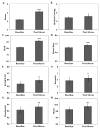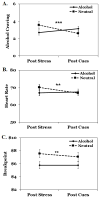Understanding the effects of stress and alcohol cues on motivation for alcohol via behavioral economics
- PMID: 24890323
- PMCID: PMC4049358
- DOI: 10.1111/acer.12423
Understanding the effects of stress and alcohol cues on motivation for alcohol via behavioral economics
Abstract
Background: Psychological stress and alcohol cues are common antecedents of both ongoing drinking and relapse. One candidate mechanism of risk from these factors is acute increases in craving, but experimental support for this hypothesis is mixed. Furthermore, the combination of stress and cues has been largely unstudied. The current study employed a behavioral economic approach to investigate the combined roles of psychosocial stress and alcohol cues on motivation for alcohol.
Methods: In a sample of 84 adult heavy drinkers, we examined the effects of an acute laboratory stress induction and an alcohol cue exposure on subjective craving and stress, arousal, and behavioral economic decision making. Primary dependent measures included an intertemporal cross-commodity multiple-choice procedure (ICCMCP), incorporating both price and delay elements, an alcohol purchase task (APT), measuring alcohol demand, and a monetary delay discounting task, measuring intertemporal choice.
Results: The stress induction significantly increased stress, craving, and the incentive value of alcohol on the ICCMCP and APT. Stress-related increases in value on the ICCMCP were mediated by increased alcohol demand. Exposure to alcohol cues only significantly affected craving, APT breakpoint, and arousal. Delay discounting was not affected by either stress or cues.
Conclusions: These results reveal unique behavioral economic dimensions of motivation for alcohol following acute stress and an alcohol cue exposure. More broadly, as the first application of this approach to understanding the role of stress in drug motivation, these findings support its utility and potential in future applications.
Keywords: Alcohol; Behavioral Economics; Craving; Incentive Value; Stress.
Copyright © 2014 by the Research Society on Alcoholism.
Figures




References
-
- Benson TA, Little CS, Henslee AM, Correia CJ. Effects of reinforcer magnitude and alternative reinforcer delay on preference for alcohol during a multiple-choice procedure. Drug Alcohol Depend. 2009;100:161–163. - PubMed
-
- Bickel WK, Marsch LA. Toward a behavioral economic understanding of drug dependence: delay discounting processes. Addiction. 2001;96:73–86. - PubMed
Publication types
MeSH terms
Grants and funding
LinkOut - more resources
Full Text Sources
Other Literature Sources
Medical

